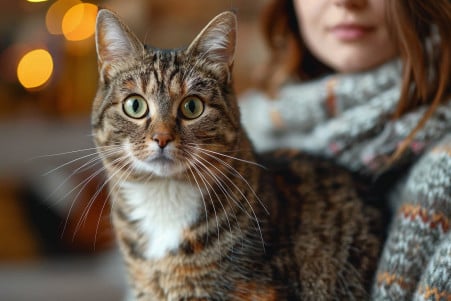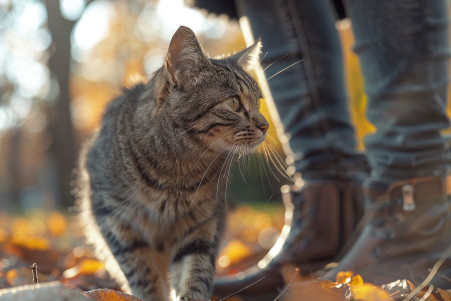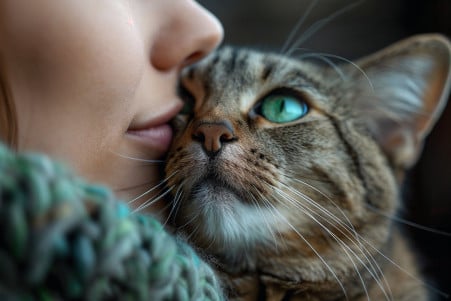Why Do Cats Sniff Each Other’s Butts? Unraveling Feline Scent Communication
11 March 2024 • Updated 10 March 2024

Cats are known for their strange behaviors, and one of the most peculiar is their tendency to sniff each other’s butts. This is a form of greeting and information gathering. Cats have anal glands that produce scents that are unique to the individual and can tell other cats about their identity, health, and reproductive status. This is just one example of how cats use scent to communicate.
This article will take a deep dive into this topic, covering a wide range of scientific disciplines including ethology, veterinary sciences, and animal psychology. By looking at research into the biological mechanisms of scent production and reception in cats, we will learn about the vital role that olfactory communication plays in cats’ social lives. This detailed look at the topic will provide a thorough understanding of the complex social structures cats have.
Why do cats sniff each other's butts?
What Do Cats’ Anal Gland Secretions Smell Like?
The scent secretions from cats’ anal glands are as unique as human fingerprints. A paper in Scientific Reports explains that the secretions are made up of volatile organic compounds (VOCs), which are important for olfactory communication.
The reason for the individual differences in these secretions is the complex microbiome of the anal glands. According to ScienceDaily, the microbiome, which includes bacteria like Corynebacterium, Bacteroides, and Proteus, is different in each cat and influenced by age, diet, and living conditions.
The microbiome of the anal glands is influenced by the cat’s genetics and environment, and in turn, influences the VOCs in the cat’s scent secretions. A paper in PMC notes that the microbiome of older cats is different from the microbiome of younger cats, showing that the microbiome is constantly changing.
To study the microbiome and VOCs of the anal glands, researchers use advanced methods like metagenomics, which sequences the DNA of the microbiome, and metabolomics, which analyzes the metabolites of the VOCs. This research helps connect the invisible world of the microbiome with the visible world of cats’ behavior, and it may lead to a better understanding of how cats’ scent secretions affect their social behavior.
The Invisible Language: Pheromones and How Cats Communicate
Cats use pheromones to communicate with one another, and these chemical signals are incredibly potent. Pheromones are odorless and are used to send social and reproductive messages. According to Cats.com, cats have more than 200 million olfactory receptors and a special organ called the Jacobson’s organ that helps them interpret pheromonal messages. This means that cats can consistently and individually identify other cats based on the pheromonal “signature” that comes from their anal glands.
Pheromones are also used in mating, and the pheromones that cats release can let other cats know when they are in heat. In addition to helping cats identify one another, pheromones also help cats interact with one another, and they can help determine the outcome of a social interaction.
For example, Catster says that pheromones can help determine whether a cat will be aggressive or friendly in a social interaction, and they can even help determine whether a cat will mark its territory aggressively or passively.
The subtleties of pheromonal communication can have a big impact on cat society, and they can help determine things like where a cat falls in the social hierarchy and how cats form relationships with one another.
To understand cat society, it’s important to understand the role that pheromones play in cat communication. The scents secreted from the anal glands, which are enriched by the resident microbiome as detailed in Scientific Reports, provide insight into the complex world of cat communication. This invisible language, decoded by an extraordinary olfactory system, is the essence of how cats perceive and navigate their social environments.
Cats Have an Amazing Sense of Smell
Cats are known for their sharp senses, and their sense of smell is especially impressive. According to Neuroscience News, a cat’s nose is structured like a super-efficient gas chromatograph, with a complex network of twisted pathways that separate the air into distinct streams for breathing and smelling. This structure allows them to smell with great precision.
A study in PLOS Computational Biology found that the olfactory system in cats is more than 100 times more efficient at detecting scents than the simple nasal passages of animals like amphibians. This level of olfactory acuity is much better than that of humans, but that’s not surprising since Wikipedia says cats have up to 200 million odor receptors.
This amazing sense of smell has a big impact on cats’ behavior and communication. Cats use their sense of smell to understand their surroundings, recognize other animals, and communicate through scent marking.
Cats’ ability to process smells so thoroughly is essential to their survival and social lives, allowing them to understand their world in ways that are hard for humans to imagine. This powerful sense is also important in maintaining the complex social structures and territories that dictate their interactions with other cats.
Understanding Feline Territories: How Cats Organize Themselves
While cats evolved as solitary hunters, their social systems have evolved to include a wide variety of social structures, from solitary to highly communal. According to International Cat Care, cats are territorial animals that use scent to mark their territories from the glands on their bodies to avoid conflict with other cats.
The social organization of domestic cats is flexible and depends on the number of cats in the area and the availability of food, but in some cases, cats have formed small matrilineal groups, similar to lions.
Because scent is so important to the establishment and maintenance of territories, territoriality is at the heart of feline social systems. As Catster explains, the matrilineal organization of feral cat colonies is based on a group of cooperating females who share the work of raising kittens and protecting the group from outside threats.
Meanwhile, male cats tend to live on the periphery, where they have larger territories that may overlap with the territories of multiple female groups, showing that cats can have a wide range of social structures.
Understanding these social systems is key to understanding how cats communicate through scent, as they provide the necessary background. Cats use scent from their anal glands and other sources not just to identify themselves but also to create the complex network of hierarchies and social relationships that make up their communities.
This knowledge of feline social systems helps us understand the complex ways that scent communication has shaped their lives, from before their domestication to the present day.
The Brain and the Sniff: How Cats Process Scent Information
The way that cats use scent to communicate is based on their neurological and cognitive systems. The olfactory bulb (OB), which is part of the brain, is the first place that scent information is processed and is the first place that scent information is integrated and interpreted. In this process, the OB first processes the information from the cat’s nose, which is highly sensitive to scent, and then sends the information to other parts of the brain for further processing.
Improving Domestic Cat Welfare Through Scent Communication
The more we learn about the complexities of scent communication in cats, the more we can improve the welfare of domestic cats and the way we manage their behavior.
For example, people who live in multi-cat households, which can be especially prone to conflict, have found a better understanding of scent marking and pheromones to be extremely helpful. As International Cat Care points out, understanding the importance of territorial marking can help people set up their homes in a way that minimizes conflict and stress.
Synthetic pheromones, including those used in products like Feliway, are designed to replicate the natural pheromones cats produce to convey comfort. People can use these products to address a variety of behavioral problems, from scratching to aggression, to help ensure a more peaceful and harmonious multi-cat household.
According to The Tiniest Tiger, these pheromones can also be used to reduce anxiety in stressful situations, such as trips to the vet or the introduction of a new pet, by signaling a safe and familiar environment.
In thinking about scent communication, we can improve the welfare of domestic cats by providing an environment that meets their instinctual needs. We can also use this knowledge to create environments that help ensure our feline companions can live together peacefully.
The Science of the Cat Butt Sniff: What It All Means for Feline Communication
As we’ve worked to understand why cats sniff each other’s butts, we’ve found that this behavior is more than just a funny quirk of our feline friends—it’s a critical part of their complex communication system. We’ve learned that the anal glands produce scents that contain important information about identity, health, and reproductive status, all of which are critical to social organization and territorial marking.
This behavior is so important in the world of cats, from one-on-one interactions to the complex relationships within cat colonies. By understanding the way pheromones work, the complexity of the feline sense of smell, and the way the brain processes scents, we can better understand our pets and their needs.
We hope that cat lovers and owners will continue to explore the ins and outs of feline scent communication to better understand their furry friends. This understanding can help us better care for our domestic cats, leading to better relationships and welfare for our feline friends.
After all, as we’ve learned, the world of cats is rich with meaning, and understanding their scents can help us better appreciate the complexity and importance of their social lives.


